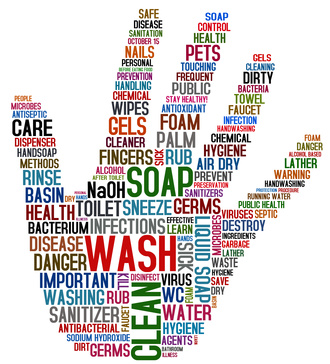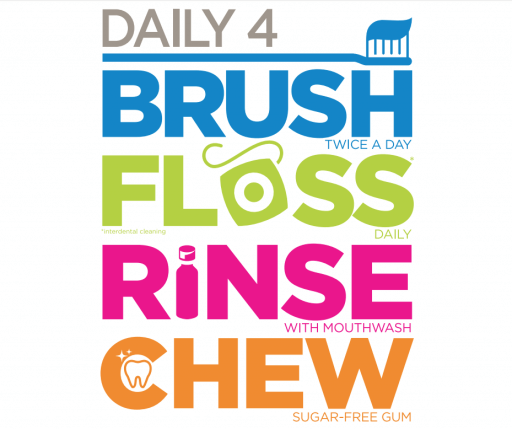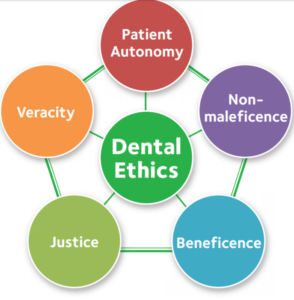Principles and Ethics
The Principles of Ethics are the aspirational goals of the profession. They provide guidance and offer justification for the Code of Professional Conduct and Advisory Opinions.
There are five fundamental principles that form the foundation of the Code: patient autonomy, nonmaleficence, beneficence, justice, and veracity. Principles can overlap each other as well as compete with each other for priority.
More than one principle can justify a given element of the Code of Professional Conduct. Principles may at times need to be balanced against each other, but, otherwise, they are the profession’s firm guideposts.
Our objectives- Understand what is meant by ethics in Dentistry.
• Understand the term “profession” and how it relates to ethics in dentistry.
• Become familiar with elements and principles of ethical decision making.
• Understand the ethics of patient relations, a delegation of duties, substance abuse in dentistry, financial arrangements, and managed care.
• Understand the difference between dental law and dental ethics.
• Define the normative theories of ethics and apply them to ethical issues in
practice.
• Understand and apply the principals of dental ethics to everyday practice.
The 5 promises dentist makes to their patients-
- Respect a patient's wants and needs- As a patient, you have the right to be involved in decisions about your treatment and to expect privacy and confidentiality. The code reminds all dentists that they have the duty to put the patient first, to involve the patient in treatment decisions in a meaningful way, and to treat the patient taking into account the patient's desires, as long as those desires are within the bounds of accepted treatment.
- Do No Harm- Our duty is to keep you safe and healthy. Part of this is keeping his or her knowledge and skills current and referring patients to specialists when necessary. “To ‘Do No Harm’ is really the Golden Rule”.
- Do Good- This means we will provide high-quality and timely treatment while considering your needs, desires, and values. To do good for a dentist means to consider each patient as an individual and whatever is in their best interest.
- Be Fair- We will not discriminate and will provide dental care without prejudice. Everyone is treated fairly, regardless of race, creed, religion, socioeconomic background, ethnicity, and current health conditions.
- Be Truthful- The best doctor-patient relationships are based on trust and honesty. Truth in diagnosis and treatment planning is so vital. Once you and your dentist have that trust, you can be partners, which will help you both gain so much going forward.
We follow the below-given Principles and Ethics -
To take care of patient our first concern
To protect and promote the health of patients and the public
We provide a good standard of practice and care
We keep our professional knowledge and skills up to date
We work with colleagues in ways that best serve patients’ interests
We treat patients as individuals and respect their dignity
We treat patients politely and considerately
We respect patients’ right to confidentiality
We work in partnership with patients
We listen to patients and respond to their concerns and preferences
We give patients the information they want or need in a way they can understand
We respect patients’ right to reach decisions about their treatment and care
We support patients in caring for themselves to improve and maintain their health
We are honest and open, and act with integrity
We act without delay if you have good reason to believe that you or a colleague may be putting patients at risk
We never discriminate unfairly against patients or colleagues.
The following are four steps to making ethical decisions relating to dental situations.
• The first step, identifying the alternatives, involves determining the most appropriate course of action, identifying the resulting circumstances of the procedure, and relaying the most important features of each treatment to the patient.
• The second step, determining what is professionally at stake, relates to the professional opinion of the dentist. The dentist must specifically consider the normative action taken in similar treatment situations and apply those considerations to the decision making process.
• The third step, determining what else is ethically at stake, takes a more broad view of what is ethically at stake for the patient in each treatment alternative.
• In step four, determining what ought to be done, or ranking the alternatives, the decision is made applying various values, virtues, rules, rights, and professional norms. No matter what the outcome, the principles of ethics come into play during every decision made regarding dental treatment.
Benefits at Smilemakers
We provide the following facilities and use of the latest technology -
We use the latest equipment and have carefully selected dental laboratories whose standards meet our own. We have selected the highest quality materials irrespective of cost to provide you with health long-lasting aesthetic results whilst preserving your tooth structure.
The clinic uses the latest technology and most advanced techniques that will benefit your oral health, increase the lifetime of your restorations, and make your visit more enjoyable.
The state of the art facilities at Smilemakers include:
1. Parking available.
2. Dental chairs are computerized, fully automatic, and state of the art.
3. Intraoral cameras for image recording.
4. Intraoral X-ray machine.
5. RVG (Digital Radiography)- With minimum radiation and Instant X-ray images.
6. Light curing units and ultra-fast lights for bonding and filling of teeth.
7. Teeth scaling and cleaning using ultrasonic scalers.
8. Root canal treatments are done using rotary endodontic systems.
9. Fiber optic handpieces for accurate and precise work.
10. Total sterilization and disinfection using the latest autoclaves.
11. Air abrasion unit for quick and effective stain removal.
12. All dental imaging, patient record management, and patient education done by software technology.
Patients have the following benefits:-
Dental Experts: We have dental experts to provide all treatments under one roof. We have cosmetic and restorative dentists, an in-house oral surgery and implant dentist and we have an in-house consultant orthodontist and when necessary they work together to provide a complete service for your dentition.
For your teeth :
Whichever dental treatment is required, we offer the most advanced and latest techniques and longest-lasting dental materials for the same. We want your own healthy and white teeth to last you for your lifetime and will aim towards educating you about proper dental care and maintenance.
For your comfort :
We understand that most people are uneasy about going to the dentist. Hence your ease and comfort are our utmost priority. We provide complete privacy as you will be treated in separate rooms. We provide a lounge area with ambient temperature to make you feel at home.
For your budget :
Once the initial check-up consultations are done, you will be informed in advance of all treatment options, costs, timeline, etc in detail. The actual treatment is started only after you are comfortable
with the entire treatment details. You will be pleased to find the most cost-effective.
For your safety :
Our clinic in Surat city has the most latest and advanced dental chair with x-ray facility and other technological gadgets including autoclaves, sterilizers, and all disposables, where required. Thus both staff and patient safety is taken care of. Our team actively participates in cross infection control courses and is fully immunized and vaccinated.
Please do not hesitate to ask if you need any further information/clarification.
Cleanliness & Hygiene

Deficient oral health has been connected to stroke and heart disease among other health issues. You can, however, raise your oral health and lessen your risk of health problems by changing particular habits.
The amount of care you give to your teeth and gums has a strong effect on your general health. Neglected oral health leads to more than just hurting teeth and bad breath, it can introduce all kinds of health issues including oral cancer.
Researchers have discovered a possible connection between gum issues and stroke, heart disease, bacterial pneumonia, and even pregnancy issues.
The professional cleaning of teeth is a crucial part of good oral hygiene and is needed periodically to maintain the health of your teeth and gums. Most dentists recommend having your teeth professionally cleaned every 6-12 months to reduce the likelihood of periodontal disease progressing. In between routine cleanings, good oral hygiene at home is vital to prevent tarter build-up and gum disease.
Infection controls and universal precautions protect clients and staff alike. Everyone benefits from rigorous infection control — you, your dentist, and the dental team. The cornerstone in a good and safe dental practice is the element of trust. You should feel free to discuss this topic with Dr. Bhairavi and receive a straightforward answer.
These measures include:
- Disinfectant hand soap
- Gloves and face masks
- Chemical disinfection of countertops and surfaces
- Sterilization of all equipment before every use
- Disposable materials
We sterilize all reusable equipment, including dental handpieces. We use an autoclave, a device that kills bacteria and viruses by steam, heat, and pressure.
The best defense against disease is information. The more you know, the better equipped you are to make wise decisions about your health care. The more you know about our daily procedures and policies, the more comfortable you will feel.
Dentists use specialized instruments to gently remove these deposits without causing harm to the teeth. All dental instruments are put through a stringent cleaning, disinfecting, and sterilizing procedure to ensure safety and quality control. A dental mirror will also be used to help the dentist inspect hard-to-see areas in the mouth.
Dental mirrors feature elongated handles generally connected to round mirrors. A dental mirror can help the dentist observe the teeth and gums for signs of irritation, swelling, decay, tarter, or bleeding. The first tool that is generally used to clean teeth is an ultrasonic instrument.
This device uses mild vibrations to loosen larger pieces of tarter. It also sprays subsequent mists of cool water to wash away loose debris. The tips of the ultrasonic instrument are rounded and curved and kept in constant motion. The settings on the device can be adjusted for the patient’s comfort.
The majority of dental patients find routine teeth cleaning to be painless. The cooling mist of water, mild vibrations, and the pressure felt during “scraping” do not generally cause discomfort.
It’s important to let your dentist know if the cleaning is beginning to cause pain so that they can recommend alternative options to make your teeth cleaning more enjoyable.
Most dental cleanings last between 30 minutes to an hour on average and are performed in a lying position in a comfortable dental chair.
After professional teeth cleaning, you may notice that your teeth feel fresher and look brighter. Teeth cleaning procedures are designed for more than just appearances.
Professional teeth cleaning treatments are the primary means of preventing and treating periodontal disease and maintaining tooth health.
Oral Hygiene

Why is Oral Hygiene so Important for You?
Adults over 35 lose more teeth to gum diseases, (periodontal disease) than from cavities. Three out of four adults are affected at some time in their life.
The best way to prevent cavities and periodontal disease is by good tooth brushing and flossing techniques performed daily.
Periodontal disease and decay are both caused by bacterial plaque. Plaque is a colorless film, which sticks to your teeth at the gum line.
Plaque constantly forms on your teeth. By thorough daily brushing and flossing, you can remove these germs and help prevent periodontal disease.
How to Brush
The dentist generally recommends using a soft to a medium toothbrush. Position the brush at a 45-degree angle where your gums and teeth meet. Gently move the brush in a circular motion several times using small,
Gentle strokes brushing the outside surfaces of your teeth. Use light pressure while putting the bristles between the teeth, but not so much pressure that you feel any discomfort.
When you are done cleaning the outside surfaces of all your teeth, follow the same directions while cleaning the inside of the back teeth.
To clean the inside surfaces of the upper and lower front teeth, hold the brush vertically. Make several gentle back-and-forth strokes over each tooth. Don’t forget to gently brush the surrounding gum tissue.
Next, you will clean the biting surfaces of your teeth by using short, gentle strokes. Change the position of the brush as often as necessary to reach and clean all surfaces.
Try to watch yourself in the mirror to make sure you clean each surface. After you are done, rinse vigorously to remove any plaque you might have loosened while brushing.
How to floss
Periodontal disease usually appears between the teeth where your toothbrush cannot reach. Flossing is a very effective way to remove plaque from those surfaces.
However, it is important to develop the proper technique. The following instructions will help you but remember it takes time and practice.
Start with a piece of floss (waxed is easier) about 18” long. Lightly wrap most of the floss around the middle finger of one hand. Wrap the rest of the floss around the middle finger of the other hand.
To clean the upper teeth, hold the floss tightly between the thumb and forefinger of each hand. Gently insert the floss tightly between the teeth using a back-and-forth motion.
Do not force the floss or try to snap it into place. Bring the floss to the gum line then curve it into a C-shape against one tooth. Slide it into the space between the gum and the tooth until you feel light resistance.
Move the floss up and down on the side of one tooth. Remember there are two tooth surfaces that need to be cleaned in each space. Continue to floss each side of all the upper teeth.
Be careful not to cut the gum tissue between the teeth. As the floss becomes soiled, turn from one finger to the other to get a fresh section.
To clean between the bottom teeth, guide the floss using the forefingers of both hands. Do not forget the backside of the last tooth on both sides, upper and lower.
When you are done, rinse vigorously with water to remove plaque and food particles. Do not be alarmed if during the first week of flossing your gums bleed or are a little sore.
If your gums hurt while flossing you could be doing it too hard or pinching the gum. As you floss daily and remove the plaque your gums will heal and the bleeding should stop.
Caring for Sensitive Teeth
Sometimes after dental treatment, teeth are sensitive to hot and cold. This should not last long, but only if the mouth is kept clean. If the mouth is not kept clean the sensitivity will remain and could become more severe.
If your teeth are especially sensitive consult with your doctor. They may recommend a medicated toothpaste or mouth rinse made especially for sensitive teeth.
Choosing Oral Hygiene Products
There are so many products on the market it can become confusing and choosing between all the products can be difficult. Here are some suggestions for choosing dental care products that will work for most patients.
Some toothbrushes have a rubber tip on the handle, this is used to massage the gums after brushing. There are also tiny brushes (interproximal toothbrushes) that clean between your teeth. If these are used improperly you could injure the gums, so discuss proper use with your doctor.
Fluoride toothpaste and mouth rinses, if used in conjunction with brushing and flossing, can reduce tooth decay as much as 40%. Remember, these rinses are not recommended for children under six years of age.
Tartar control toothpaste will reduce tartar above the gum line, but gum disease starts below the gum line so these products have not been proven to reduce the early stage of gum disease.
Professional Cleaning
Daily brushing and flossing will keep dental calculus to a minimum, but a professional cleaning will remove calculus in places your toothbrush and floss have missed. Your visit to our office is an important part of your program to prevent gum disease. Keep your teeth for your lifetime.
Other important factors affecting the health of your gums include:
- Smoking
- Diabetes
- Stress
- Clenching and grinding teeth
- Medication
- Poor nutrition.
Emergency

In an Emergency
Stay calm. Focus on stopping the bleeding and protecting the injured tooth or area by following the appropriate instructions in this section.
Never take aspirin or ibuprofen for a dental emergency because they are anticoagulants which can cause excessive bleeding. To alleviate pain, take acetaminophen as directed on the packaging label.
Injuries to your teeth and gums can result in infection or other complications -- so make sure you see your Dentist.
Severe Pain
The most common causes are debris lodged under the gum line, a lost filling or crown, a cracked or broken tooth, or an infection. Only a thorough examination by a Dentist can determine the underlying cause of severe pain.
Until you see your Dentist, apply ice to the painful area for 10-20 minutes of every hour. To alleviate pain, take acetaminophen as directed on the packaging label.
Possible Broken Jaw
Do not move your jaw. Secure your jaw in place with a handkerchief, necktie, or towel tied around the jaw and over the top of the head. Use cold compresses to reduce swelling.
Toothache
Clean your mouth out by rinsing thoroughly with warm water. Gently floss around the tooth to remove any food particles that may be trapped between your teeth or just under your gum line. If your tooth continues to hurt, see your dentist as soon as possible.
Teeth
Debris between Teeth
Carefully insert a piece of dental floss (never a sharp or pointed object) between your teeth. Be gentle so you do not cut the gum tissue. If you are unable to remove the object, see your dentist right away.
Loose Tooth
Whether removable or fixed, a bridge is attached to abutments that provide an anchor of support.
Chipped or Broken Tooth
It may be possible to reattach the pieces to your tooth - only your Dentist can tell you for sure. Take the following steps and see your Dentist right away. Remember to take the pieces with you.
For the injured person:
Rinse your mouth with warm water to clean it. Apply gauze to the area and use firm pressure to stop the bleeding. Try to find the chipped or broken tooth pieces right away.
When the bleeding stops, apply a cold compress to the injured area to minimize swelling. If bleeding does not stop after 10 minutes of constant, firm pressure, see your dentist or go to the emergency room.
For the chipped or broken tooth
Save the tooth's pieces and rinse the pieces and your mouth with warm water. If the tooth's pieces are dirty, place a towel or dishcloth in a sink (so the pieces cannot fall into the drain), and gently rinse them.
Place the pieces in a small container and cover them with milk, water with a pinch of salt, or saliva from the injured person.
For the broken tooth:
- Hold the tooth only by its crown (the enamel, visible portion). If the tooth or root is dirty, place a towel or dishcloth in a sink (so the tooth cannot fall into the drain), and gently rinse the tooth and root but DO NOT SCRUB it or remove any gum tissue that may still be attached to the root.
- If possible, gently place the tooth back into its gum socket facing the correct direction (making sure that you do not force the tooth back in place). If this is not possible, place the tooth in a small container and cover the tooth in milk, water with a pinch of salt, or saliva from the injured person.
For the Injured Person:
- Rinse your mouth with warm water to clean it. Apply gauze to the area and use firm pressure to stop the bleeding. Try to find the missing tooth right away.
- When the bleeding stops, apply a cold compress to the injured area to minimize swelling. If bleeding does not stop after 10 minutes of constant, firm pressure, see your dentist or go to the emergency room.
- Place the tooth in a small container and cover it with milk, water with a pinch of salt, or saliva from the injured person.

